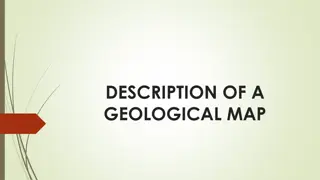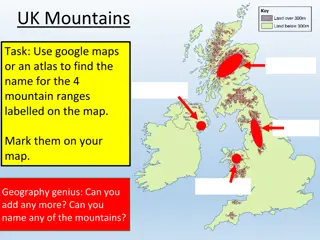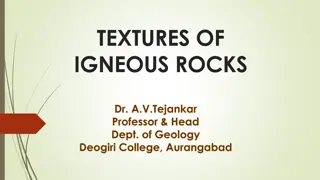Understanding Geological Maps: Interpretation and Description
Training in geological map interpretation aims to accurately identify features depicted on maps through careful examination of geological information. The description of a geological map involves a chronological synthesis of geological data, analysis of the geology of an area focusing on relief, suc
0 views • 15 slides
Understanding Magmatic Differentiation and Magma Mixing
Magmatic differentiation is the process through which a single homogeneous magma can produce diverse rock types by generating fractions of different compositions. This variation in igneous rocks results from mechanisms like fractional crystallization, liquid immiscibility, vapor transport, and diffu
1 views • 29 slides
Understanding the Rock Cycle: Igneous, Sedimentary, and Metamorphic Rocks
This educational material covers the formation and characteristics of Igneous, Sedimentary, and Metamorphic rocks. It includes details on the processes involved, such as heat melting rocks into magma, sediment formation through erosion and deposition, and the differentiation between intrusive and ex
1 views • 16 slides
Exploring UK Mountains and Rock Formations: A Geographical Journey
Uncover the mysteries of UK mountains and rock formations through a fascinating exploration of mountain ranges, such as the Grampian Mountains and Pennines, and various rock types like Sedimentary, Igneous, and Metamorphic. Discover how the geological landscape is shaped by the type of rock present
1 views • 13 slides
Understanding Textures of Igneous Rocks in Geology
Structures associated with igneous rocks are primary features that contribute to their strength, distinguish rock groups, and reveal origin. Textures, like crystalline patterns, indicate cooling and crystallization processes. Different cooling rates lead to varied textures such as holocrystalline, h
0 views • 16 slides
Importance of Rocks in Construction and Building Materials
Rocks play a crucial role in construction as geological materials for foundations and building structures. They are classified into igneous, sedimentary, and metamorphic categories based on their composition and properties. Traditional stone masonry is being replaced by modern techniques like stone
1 views • 15 slides
Understanding Rocks: Types, Formation, and Properties
Rocks can be classified as metamorphic, igneous, or sedimentary based on their formation processes. Florida's phosphate deposits and pumice formation showcase the diversity of rocks. A scientist's rock cycle model helps predict changes, while pressure on sediments leads to new rock formation. Basalt
1 views • 22 slides
Understanding Different Types of Rocks and How They Form
Rocks are essential components of Earth's crust, consisting of various minerals held together by natural cement. They can be categorized into three groups: Igneous, Sedimentary, and Metamorphic rocks. Each group is formed differently, either through volcanic activity, sedimentation, or existing rock
3 views • 16 slides
Understanding Rocks and Minerals: Types and Formation
Rocks and minerals are natural substances with distinct characteristics. Rocks are solid aggregates of minerals or mineraloids, while minerals are naturally occurring chemical compounds. There are three main types of rocks: igneous, sedimentary, and metamorphic, each formed through different process
0 views • 16 slides
Evolution of Igneous Activity in Various Hotspot Areas Over Millions of Years
Detailed historical account of igneous activity in hotspot regions such as Iceland, Eifel, Azores, and Canary Islands from Morgan's study. The progression of volcanic events over different geologic periods is illustrated through images and descriptions. The timeline ranges from 200 Ma to present fin
0 views • 13 slides
Comprehensive Classification of Aggregates and Their Characteristics
Classification of aggregates based on production methods (natural, by-product, processed, colored), petrological characteristics (igneous, sedimentary), and particle size (fine aggregate, coarse aggregate). Examples and images are included for better understanding.
0 views • 5 slides
Understanding Rocks: Types, Formation, and Importance in Geology
Rocks are solid accumulations of minerals found in the Earth's lithosphere. They are classified into igneous, sedimentary, and metamorphic types based on their mineral composition. Rocks play a crucial role as geological materials for construction and historical buildings. Learn about the properties
0 views • 31 slides
Geology Test Review: Rocks and Minerals
This review covers the identification of rocks as igneous, sedimentary, or metamorphic, along with definitions and properties of minerals like cleavage, crystal structure, streak color, and more. It also discusses the classification of rocks as foliated or nonfoliated. Prepare for your geology test
2 views • 112 slides
Exploring Rocks: A 7th Grade Science Book on the Rock Cycle
Dive into the world of rocks with this comprehensive 7th-grade science book. Learn about the different types of rocks - igneous, metamorphic, and sedimentary. Explore how rocks are formed and categorized, and discover the processes that shape our Earth's rocky landscapes. Engage in hands-on activiti
0 views • 24 slides
Understanding Rock Formation and the Rock Cycle
Explore how the Earth's surface is formed through the classification of rocks based on their processes of formation. Learn about different rock types such as igneous, sedimentary, and metamorphic rocks, and understand concepts like the rock cycle and the effects of pressure on sedimentary rocks.
0 views • 13 slides
Understanding Economic Geology: A Comprehensive Overview
Economic geology, as discussed in the provided content, delves into the commercial and industrial utilization of Earth's resources. Covering topics such as mineral deposits, ores, gangue minerals, common economic minerals, and classification of mineral deposits, this field plays a crucial role in id
0 views • 33 slides
Stratigraphy and Mineralogy of Northeast Syrtis Major
High-resolution work on Northeast Syrtis Major reveals diverse igneous lithologies and alteration products in a clear stratigraphy. The region displays great morphological heterogeneity at a decameter scale, yet it can be unified under five distinct geomorphic units. Geomorphic mapping and stratigra
0 views • 31 slides
Understanding Pyroxene Group in Geology: Composition and Significance
Pyroxenes are vital rock-forming minerals found in various types of igneous rocks and metamorphic conditions. They consist of linked SiO4 tetrahedra, forming structural chains with specific chemical compositions. The orthorhombic and monoclinic pyroxenes play essential roles in geology, demonstratin
0 views • 15 slides
Exploring Diverse Igneous Geology in and around the Columbia Hills
Studying the diverse igneous geology in and around the Columbia Hills provides insights into Martian atmosphere, volatile budget, age, source characteristics, cooling history, and more. Researchers have uncovered valuable information by coupling unaltered igneous rocks with meteorites and surface sp
0 views • 19 slides
All About Arfvedsonite: Rare Mineral Formation and Properties
Arfvedsonite is a rare mineral that is only formed in iron-rich igneous intrusions associated with nepheline syenites and pegmatites. Discovered in 1823 and named after Swedish chemist Johan Arfwedson, it has a distinctive chemical formula and structure as an amphibole mineral. Its physical properti
0 views • 9 slides
All About Chalcopyrite: A Shiny Metallic Mineral
Shiny and metallic, chalcopyrite is a mineral that comes in various colors, with a brass-yellow appearance and often an iridescent tarnish. Forming in igneous and metamorphic rocks, it is commonly found alongside other copper sulfide minerals. Chalcopyrite is a primary ore mined for copper, known fo
0 views • 7 slides
Understanding Rocks and the Rock Cycle
Explore the world of rocks through this educational content on Earth's surface, rock cycle, rock types (igneous, sedimentary, metamorphic), and the formation of igneous rocks from magma and lava. Learn how rocks are made of minerals, the continuous process of the rock cycle, and the classification o
0 views • 29 slides
Understanding the Rock Cycle Process
Exploring the rock cycle, which involves the formation, transformation, and breakdown of rocks into three main types: sedimentary, igneous, and metamorphic. Learn about how rocks change through processes like heat, pressure, erosion, and melting.
0 views • 9 slides
Understanding Rock Classification in 7th Grade Science
When studying rocks, scientists analyze their mineral composition, color, and texture. Rock-forming minerals play a significant role in Earth's geology, with granite and basalt being prime examples. The texture of rocks is determined by the size, shape, and pattern of grains present. Rocks form thro
0 views • 9 slides























